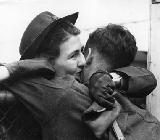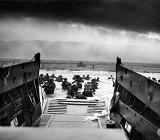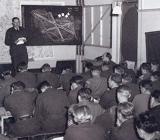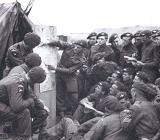The Gold Beach Landings
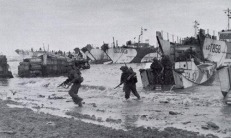
Royal Marine Commandos landing D-Day
Led by the tanks of the 79th Armoured Division and the Royal Dragoon Guards, three brigades of the 50th British Infantry Division came ashore here. With the Canadian Third Infantry Division assaulting on their immediate left flank, the 69th Infantry Brigade pushed inland to the town of Creully, where on June the 8th General Bernard Montgommery would set up his TAC Headquarters. It was during this advance that CSM Stanley Hollis would win the only Victoria Cross awarded for Valour on D-Day. At the same time, the 231st Brigade pushed south-west as far as the outskirts of Bayeux, 5 miles (8km) inland, which they captured the following day, June 7th. The first large town liberated after D-Day, Bayeux also holds the largest British Cemetery in Normandy, with a total of 4648 graves of which 466 are Germans. The cemetery is situated beside the By-pass, the road constructed by the British engineers to relieve Military traffic congestion in the town immediately following the D-Day Landings. Located opposite the cemetery is the Memorial to the 1808 Commonwealth soldiers who were posted “Missing in action” during the fighting in 1944, whose bodies were never identified and who have no known grave. The Latin inscription on the Memorial to the Missing reminds visitors that the British who liberated Normandy in 1944 were the same ones invaded by William the Conqueror nine centuries earlier.
The Battle Sites/Sights
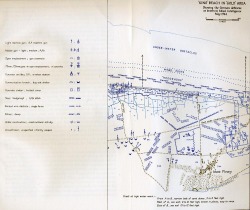
Map of German Beach Defenses Gold Beach
In the two hours before the Gold beach Landings started landings started, the offshore fleet of Force G came under fire from the 152mm German Gun Battery at Longues sur Mer, although the fire was ineffective and no Allied ships were hit. Fire was returned by HMS Ajax and other ships and the gun battery fell silent at 0730am. It was then that the 1st Battalion, Hampshire Regiment and the 1st Battalion, Dorsetshire Regiment, both of the 231st Brigade, stormed ashore onto the beaches of the seaside town of Asnelles at 07:30am. Asnelles, the western most village on Gold beach is situated in Jig Sector of the D-Day Landing sectors. Carried by the strong winds and currents, all of the assault units landed about a quarter of a mile (400 meters) too far to the east of their intended landing sectors. When the reserve battalion arrived on the beach, they too found themselves off course to the east. Following a fierce firefight in which confusion seemed to be the order of the day, the 231st Brigade managed to make their way off the beaches to reorganize themselves for the push inland. Even as they did this they left strong German positions on the beach still fighting, intact and in enemy hands. These strong-points would be dealt with later by the mobile field artillery of the Essex Yeomanry. The 47th Royal Marine Commandos also had a difficult landing. Scheduled to land at 0930am, 2 hours after the first wave, when they arrived instead of finding the beach secure and the first wave advancing inland, they found the German beach defenses still largely intact and occupied. Suffering the loss of several craft and the equipment they carried, it was not until noon that the Commandos set off to their objective, the village of Port en Bessin where they were to link up with the US 26th Regiment coming from Omaha Beach.
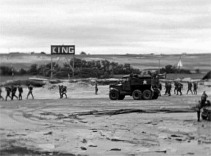
British troops landing on Gold Beach
The 69th brigade of the 50th spearheaded the assault at the eastern end of Gold beach in King Sector, centered on the seaside village of Ver sur Mer. Here was located a number of large concrete German gun emplacements, one of them housing a much feared 88mm anti-tank gun. The assault was led by the 5th Battalion of the East Yorkshire Regiment and the 6th Battalion of the Green Howards, supported by the tanks of the 79th Armoured division and the the 4/7th Armoured Battalion of the Royal Dragoon Guards. Here at the eastern end of Gold beach the pre-invasion bombardment by air and sea had proved to be reasonably effective and the lead assault companies of the Green Howards were able to take advantage of the disorder that this had created among the German defenders. The seafront defenses were quickly overcome and the German gun battery at Mont Fleury, situated about six hundred meters (a third of a mile) inland was also rapidly neutralized, largely thanks to the actions of Company Sergeant Major Stanley Hollis, who was later awarded the Victoria Cross for this action and others that he performed on D-day, and the British forces moved on to link up with elements of the 3rd Canadian Division in the village of Creully, located about eight kilometers (five miles) inland. The Green Howards companion assault Battalion on their right, the East Yorkshire Regiment, had a more difficult time however. The large German Gun position known as WN-33 which housed several anti-tank guns, including an 88mm anti-tank gun, held up repeated assaults against it and was pounded mercilessly by the Royal Naval support ships offshore but was only finally subdued in the late morning when a Sherman 'Crab' tank of the Royal Dragoons managed to fire several 75mm rounds through the aperture which put the gun out of action.
Longues sur Mer Gun Battery
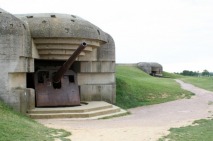
German Gun Battery at Longues sur Mer
Situated about 6 miles (10 km) east of Omaha Beach and 4 miles (6 km) west of Gold Beach, this gun battery was perfectly positioned to fire on the landing fleets of both of these landing beaches. Despite 1,200 tons of bombs dropped on this position by the Allies in the run up to D-Day, they had succeeded in hitting only one of the four massive bunkers. Even this hit did not knock the gun out though and on the morning of D-Day this was the very first German coastal battery to engage the Allied Landing fleet, opening fire at about 5:30am. Fortunately for the Allies the Germans had more than enough of their own problems that day and even with the guns firing for a total of over four hours on D-Day, the German gunners did not succeeded in hitting a single Allied ship. The battery was finally knocked out in the evening of D-Day by Allied Naval gunfire and it's demoralised garrison surrendered to the advancing British forces the next day. Today, you can still see the gun battery installed at Longues sur Mer by the Germans in early 1944. The guns are still in the bunkers, left much as they were in 1944 after the fighting was over. All of the guns and their bunkers still show the scars of battle from 1944 except for one which is in almost perfect condition. The footprints of a German soldier who stepped onto the concrete floor while the cement was still wet can also still clearly be seen.
The Mulberry Harbour
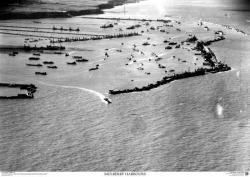
Mulberry B Artificial Harbour Summer 1944
The Mulberry harbours were a secret Allied project set up right after the landings, centered on the Norman seaside towns of Arromanches at the very western end of Gold beach and Vierville sur Mer at the Western end of Omaha beach. These harbours were to be constructed in England, composed mainly of hollow concrete caissons, the largest of which was over twenty meters high, seventeen meters wide and more than sixty meters long weighing over six thousand tonnes (sixty feet high, fifty feet wide and two hundred feet long), These were to be brought over from England on D-Day, the first pieces arriving on the morning of June 7th. Construction proceeded rapidly as the two ports were to be the main supply ports for the Landings. The American Mulberry harbour was unloading tanks along the floating roadways by June 8th, but the British port was slower to come to completion. This was to show as the storm which raged from June 19th to June 22nd 1944 completly destroyed the American Mulberry, while the slower but more securely assambled British Mulberry could be repaired. Canabilising the American Harbour for the few unbroken pieces that could be re-used, the British Mulberry was up and running again by the middle of July. By that stage the Harbour had completly out-paced even it's constructors estimates as to what maximum daily tonnage could be unloaded, each new daily unloading record to be surpassed again the next day. The harbour was used until Winter 1944 when it was finally shut down. Nowadays, there is some 40 percent of the British Muberry left to view, but only one caisson remains on Omaha Beach.
Arromanches Radar Station
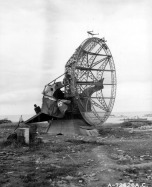
Radar Dish at Arromanches
The German Radar station installed on top of the cliffs just to the east of the town of Arromanches was bombed at the end of May 1944 and was not working on D-day, but the concrete emplacements for the large Wurtzburg radar dish are still there, with the control room bunker just beside it. The concrete roofs of the tunnels running underground between the various bunkers in the complex are also still clearly visible running across the grass behind the cliff-tops. This position also gives an excellent panoramic view of the Mulberry Harbour centered on the town of Arromanches.
Asnelles sur Mer
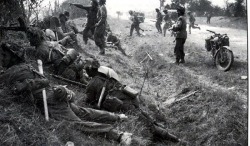
British Troops outside Bayeux June 6th 1944
You will be shown the beachfront at Asnelles where one of the feared German 88mm Anti-tank guns was located, the bunker still showing the scars of where it was hit by Allied shells on the morning of June 6th 1944. The car park this bunker now stands in fronts onto the beach, with the German anti tank wall now stopping tourists from driving their cars onto the sand and one of the car park spaces which will never be free to park in as it is permanently occupied with the smashed remains of a German Machine Gun nest.
CSM Stanley Hollis, Victoria Cross
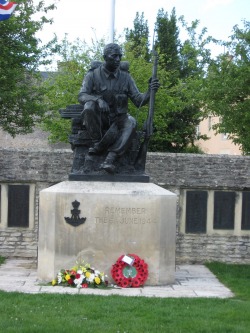
Statue in commemoration of Sgt Hollis, VC
You will be shown the train stop shelter on the beach near where Sgt. Hollis landed on D-Day. Despite its pre-war construction, this small building was mistaken for a German machine gun bunker in reconnaissance photos and was given as a target to be destroyed in the pre-invasion bombardment on D-Day. Even though the shelter is of flimsy construction and it receiving close attention from four Royal Navy gunships on the morning of June 6th, it remained untouched.
Unfortunately, you will be shown that most of the Mont Fleury gun battery where the action took place that Sgt Hollis was later awarded his Victoria Cross for is now largely built on top of being taken up by a new housing estate. The site can still be visited though and you can see that the bunkers are still clearly visible, and some are still left as they were, only half constructed, on the morning of June 6th, 1944, the evidence of the hasty building work still around.
In the village of Crepon stands the life size statue of Sgt Stanley Hollis, VC, near the site of the second action he performed on D-Day for which he was later awarded his Victoria Cross. It was near here (now on private grounds) that he rescued a section that had been cut off and was in danger of being over-run by the Germans. It shows the recognition deserving of being awarded such a rare token of outstanding valour.
Unfortunately, you will be shown that most of the Mont Fleury gun battery where the action took place that Sgt Hollis was later awarded his Victoria Cross for is now largely built on top of being taken up by a new housing estate. The site can still be visited though and you can see that the bunkers are still clearly visible, and some are still left as they were, only half constructed, on the morning of June 6th, 1944, the evidence of the hasty building work still around.
In the village of Crepon stands the life size statue of Sgt Stanley Hollis, VC, near the site of the second action he performed on D-Day for which he was later awarded his Victoria Cross. It was near here (now on private grounds) that he rescued a section that had been cut off and was in danger of being over-run by the Germans. It shows the recognition deserving of being awarded such a rare token of outstanding valour.
